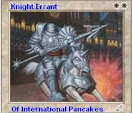I start to get a pretty good idea where my boat is leaking. I use my own games to have a good look at the leaks at both sides. There are different areas that need attention. The first division in type of categories is skill and knowledge.
I postulated that Result = Skill x Knowledge = How x What
Furthermore, I postulated that skill is the fundamental "trick" that makes child prodigies to become grandmaster at the age of 14. Whereas the knowledge is provided by their coaches.
Both Skill and Knowledge have their own problems.
Recently, I'm studying Birds and Latin vocabulary with the aid of Anki. I noticed that in both studies I suffer from the same problem, which I will call the "priest problem" from now on. It is the problem that you need to add more energy during the learning process. To begin with Latin, there are words that are hard to learn because they seem unmeaningful, and no associations are coupled to them:
Etcetera. As you see, it are often short words, there is not much to go on, and it is difficult to find an association.
For bird sounds, it is even worse. The sounds are often sounding the same, there are songs, calls, alarms and different reasons for birds to produce sounds. And we have no language to base an association on. Furthermore, there are good imitators among them.
To learn these difficult to learn items, you must add sufficient extra energy to the learning process. You must take a resilient flashcard, and decide not to click it away before you are sure you know it. You must build artificial associations, even when there aren't any natural ones. And before all, you must keep an administration of the mistakes and realize that you cannot go any further before you absorbed them.
The next diagram is from my own game. I played black and have just threatened my opponent's knight with 20. ... a4
 |
| BE AWARE! White to move! |
2r2rk1/1p3p1p/1q4p1/3p2b1/p1nN4/1NP2P2/PPQ1R1PP/1R5K w - - 0 21
After 5 minutes of thinking he played 21.Nd2??
Which is a blunder, ofcourse. Why did he make this blunder? Usually he is very good at counting defenders and attackers. That is the skill he used. On d2 his knight is attacked twice and defended twice. But what was not in his skill, was that he wasn't able to SEE that the defenders cannot defend at all because they have too high a value.
The hunt for skill is based on hunting for these type of skills. If you don't realize you have a problem, you will not give the subject enough energy. It is like a flashcard which you click away without absorbing it. And my opponent can be sure to make this mistake again.
The skills you need to obtain are not rocket science. But before you can obtain them, you must know what exactly the problem is. What did you miss and and why did you miss it? And be sure to add enough energy to the solution so that you won't make this mistake again!
Of course my opponent could have calculated the move. That would have disguised the lack of skill, and the problem would have gone by unnoticed. But blundering and ignoring the problem is even more hideous. Yet that is what we do all the time.
Knowledge
Earlier in the game I was saddled with an isolani. The moment I noticed it, it was too late to prevent it.
 |
| BEWARE! White to move |
This happened after
- 1. e4 e6
- 2. d4 d5
- 3. Nd2 c5
- 4. exd5 exd5
- 5. Ngf3 Nf6
This showed a leak in my boat. After 4.exd5 I can safely take back with the Queen and avoid the isolani.
But that is not what I wanted to show you. After the game, we talked about the isolani, and he started to recite some platitudes from GM Euwe about it, like "you don't need to worry about getting an isolani, there is still a lot to be played for", or something like that.
Well, that was not my first problem, I don't mind an isolani, when I choose for it deliberately or when I cannot avoid it. That was not the case here.
The problem for my opponent was, that his knowledge about the isolani was in fact pseudo knowledge. Since he had no real idea how to play the position. I immediately shifted gears, and started to avoid any trades and to add all kinds of pressure to the position.
It shows that a lot of our knowledge is in fact pseudo knowledge. It prevents us from digging deeper because we think we already know.
And it is always easier to see what other people are doing wrong than to look at ourselves.
Btw, beware of the priest problem!








